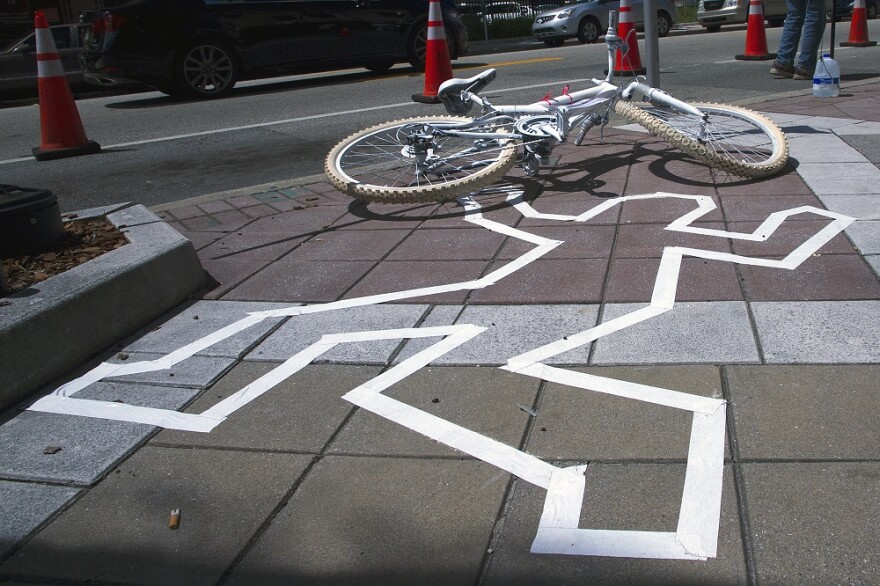A two-wheeler was the object of much longing when I was a kid. I got mine around grade five and more than 60 years later I'm still at it — riding between 40 and 50 miles a week.It's great exercise and fun, but it can be dangerous.
Mostly, I bike in light traffic — where the speed limit is 25 miles an hour. Even so I have to be on high alert because at any moment someone may rush out of a driveway; or ignore my right of way in an intersection; or pass me with inches to spare; or — within 20 yards of a stop sign — speed up to pass me, cross a double line, pull in front and quickly stop for the crossing.
It's not that they can't see me.... I'm 6 foot 5 inches tall, ride an oversized bike, wear a florescent yellow shirt and have a flashing red light on the back of the frame. While most four-wheelers do allow plenty of space, it only takes one oblivious driver to ruin a day — or a life.
Of course each of us, motorist, cyclist or pedestrian, has a responsibility to put safety first. But regarding consequences, the odds are against those not surrounded by steel. In Jacksonville last year 554 vehicular crashes claimed 43 riders and pedestrians.
It's not like this everywhere. the just-out 2014 benchmarking report by the Alliance for Biking and Walking has some compelling figures. For simplicity, we'll keep it to bikes.
The standard measurement is fatalities, per 10,000 commuters, per year — averaged over 3 years.
The national figure is 8.5 bike fatalities a year. Florida's average is 21.1— 44th worst of 50 states. (By comparison Massachusetts' average is 5th lowest at 2.7).
Of 52 largest cities, Jacksonville ranks 49th — 33.1 fatalities per 10,000 bicycle commuters. In traffic plagued Los Angeles it's 4.3.
Why? Other locations work at bike safety. I know two cities that have been at this for years — Fort Wayne, Indiana and Pittsburg, Pa. Both overcame streets built before cars came, both have multiple rivers that snarl traffic patterns, both have population bases smaller than Jacksonville's.
Both have extensive, beautiful bicycle networks.
Fort Wayne: Almost 70 miles of multipurpose trails, more than 50 miles of which are interconnected.
Pittsburgh: More than 20 miles of paved trails downtown alone — connecting to a network that lets bicyclists pedal all the way to Washington D.C.
Jacksonville has a lovely, paved 14.5 mile bike trail — with a trailhead virtually on the Nassau County line. A great facility, far from the population center, contributing nothing to support everyday bicycle use or commuting.
But signs of improvements are on the horizon. Jacksonville now has a coordinator to handle bicycle and pedestrian issues. The City Council approved a committee to ensure all modes of transportation are considered in making roadway decisions. There's a JAX 2025 Bicycle and Pedestrian Task Force, and other bike groups are activating as well. Like one called One Road.
One Road, as in, there's just one road, lets all share it safely. They use "ghost bikes" — displays, featuring bicycles from wrecks, painted white — to make us think about the consequences of drivers not being aware of surrounding traffic, speeding, rudeness or being a four wheeled bully.
Not that cyclists don't cause problems — I certainly have done some dumb things. Riding more than two abreast is a common issue as is running intersections, riding against traffic, not signaling, riding without head and tail lights after dark and being the wrong place in the lane.
Lane issues seem to be the most likely to provoke anger on all sides, but might be defused by reading Florida law on bikes and traffic. A cyclist is entitled to use the entire lane when a lane is too narrow for a bicycle and a car to share safely. Usually the rider takes the right half to be visible to all traffic.
The law says to ride as far right as practicable — not as far right as possible.
Most cycling hazards, like trash or car doors opening, are on the right side of the road — the biker moves right based on conditions.
Also, a passing motorist must leave at least 36 inches clearance — that's three feet from car mirror to handlebar. In return riders should demonstrate courtesy and not hold more lane than needed. As with most things, it comes down to mutual respect.
The ultimate solution, A network of bike lanes and trails, is good for traffic, health and the economy. Until that happens, smile and wave to each other — using all five fingers.
Jay Solomon is a retired broadcast executive and an occasional contributor to First Coast Connect.





